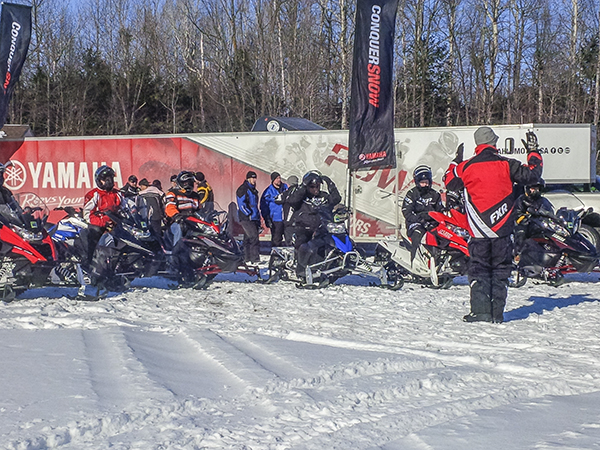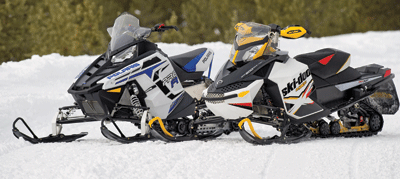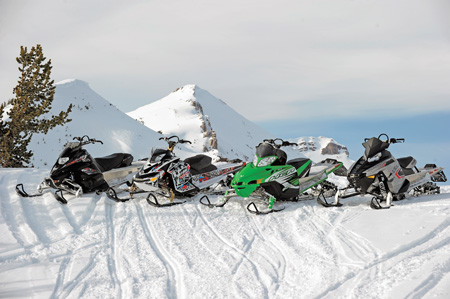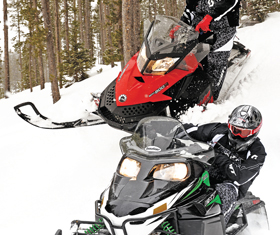
If this sled was lined up at the starting line next to others in this group with a stretch of the rough stuff ahead, it would not be the first sled we’d choose to be aboard. But it wouldn’t be the last, either. It can hold its own in the bumps, but not as well as others.
On the other hand, line up the same group at a starting line with a smooth stretch-o-trail ahead, and there would be some serious arm wrestling for who got to pilot the blue and silver.
“If I were to take a long trail ride on smooth terrain on my choice of sleds, I wouldn’t hesitate to choose the Vector,” said Rode Reports Guest Rider Jamie Seh of Syracuse, New York.
A rear suspension change on the RS Vector ER is the hype for 2006. It’s an excellent feature for the luxury-seeking rider. While the base RS Vector uses the Pro Active suspension, the engineers at Yamaha decided to give its customers more comfort and adjustability with the Mono Shock RA rear suspension on the 2006 RS Vector ER. The factory’s premium suspension, which debuted on the 2005 RX-1, delivers a smooth ride on the trails and does a decent job in smaller bumps. The Camoplast Rip Saw track is back.
The real cherry on top of this suspension sundae is its easy adjustability. A convenient dial located on the left side of the tunnel allows the rider to switch from a soft to stiff setup with no more than a flip of the wrist.
Guest Rider Melissa Hinderschied of Rockville, Minnesota, said that if she could create the ultimate sled by compiling parts from each manufacturer, Yamaha’s suspension technology would be a necessity.
The suspension’s adjustability is not the only thing on this machine that’s smooth. The Genesis 120 engine makes the sled feel like it’s flying through the clouds rather than scooting along on the snow. And the ramp-up in rpm just sounds cool.
With little to no vibration and a quiet engine, the RS Vector ER is tough to rival in this category. It’s clean, too, reducing emissions beyond EPA standards.
Though it’s not as quick at Cat’s 600, it responds with ample power. (The throttle is stiff compared to the RS Vector ER’s competitors — an unfortunate Yamaha trait throughout its lineup.)
With the über-efficient four-stroker under the hood, the RS Vector ER gets top-notch fuel economy.
This is a machine geared toward riders who want the sled to do most of the work. This isn’t to say a rider can’t lean into the corners on the ER, but the sled is designed for more laid-back riding.
When taken into the corners in a more aggressive riding position, the sled lost some stability and gave slight ski-lift, just like the standard RS Vector and RS Vector GT.
At the end of the day, this sled has got reliability written all over it. It’s got all the comfortable amenities of a luxury sled without sacrificing the technology and performance true sledheads look for from their machines.
The Bells And Whistles
If the RS Vector ER was walking down the runway in the evening gown portion of a beauty pageant, the commentator would surely call its look elegant with a splash of edginess. Or maybe even understated but sharp.
This sled looks slick with its Fire and Ice graphics package, which is new for 2006. And the RS Vector ER’s body-type wears the graphics package well.
Where this sled misses the mark entirely is storage (if we can even call it that). The “storage” on this sled is laughable. In fact, we actually did laugh after searching for a few minutes and finally locating the 2 x 2 inch mini-compartment under the hood that resembled something like half of a cup holder. Yamaha said this sled was geared toward the luxury groomed trail customer who’s apt to log lots of miles in a day, right? We don’t know many riders who only hope to pack one sock or half of a candy bar, which is about the amount of space the RS Vector ER allows for, for a long day on the trail.
On the positive side, the windshield keeps the rider protected and warm on a long, cold day and the handwarmers are worthy of a standing ovation. They are easily adjustable and as toasty as a warm evening in front of a crackling fire.
A question which must be asked: Why no rearview mirrors on this otherwise maxed out luxury ride? Every other machine we rode in this group sports the rearviews, and Yamaha delivers such an array of amenities on the RS Vector ER that it seems like a blatant oversight to not have mirrors. They should come standard.
Though riders may have to turn their heads to look back, their backsides will be comfortable. Picture a cushy La-Z-Boy nailed to a snowmobile and that’s what the ER’s seat feels like. It is soft and provides a great amount of cushion.
Sabercat 600 EFI LX
As far as improvements and changes Arctic Cat made to its Sabercat 600 EFI LX for 2006, let’s just say customers are getting the same sled as last year in terms of performance and handling.
Cat did give the 600cc engine an updated EFI II system. Though they’re attaching the “II” to the EFI, it is essentially the same engine as last year with an exhaust-pipe temperature sensor (EPTS) on the pipe to help it burn cleaner.
Cat claims the sensor will improve the sled’s fuel mileage and allow it to warm up and accelerate quicker. This may be true, but the improvements are minimal and hard to identify from the seat.
It doesn’t improve or take away from the power or ride quality the Cat customer has come to expect from the 600cc engine. The power this engine delivers is in the mid-range when compared to competitors in its class.
The engine is still too noisy for what the consumer in this class is looking for. The sled would benefit from a reduction in vibration, too.
The 2006 Sabercat 600 EFI LX is in its third year on the same chassis — the same chassis used in the Firecat lineup now for four model years. The chassis is lightweight and allows for good ergonomics and comfortable handling. It would be nice to see some new technology in the chassis department next season, though.
The ergos move the rider down, giving it a lower, more stable feel. The Sabercat also responds well to weight transfer in the corners, which is necessary if a rider hopes to avoid ski push. Bottom line: It’s a lean-in-the-corners type of ride.
The AWS VI front suspension handles bumps well. The FasTrack rear suspension was less impressive in the rough stuff, though.
The ACT position sensitive shock gets firmer as it compresses, which provides a supple ride at slow speeds and a firmer feel when the speeds pick up. Compared to the Firecat, even the stiffest setting is soft, said Guest Rider Andy Jarnot of St. Paul, Minnesota. “[The Sabercat 600] is soft riding but [it] floats like a Buick over the bumps,” he said. “It works well for groomed trails and perfect on bumps up to 6 or 8 inches.”
More than its competitors in this class, the Sabercat may need additional adjustments beyond dealer setup for maximum personalization.
The Bells And Whistles
If this sled were a woman walking into a bar, it would get more head-turns than any of its competitors — by far. This machine looks good. The body style — especially the available cherry red — and the graphics (which are sharp yet subdued and classy) combine for a hot look that really grabs the attention of the luxury touring customer.
One of the best bells-and-whistles feature on this machine is its removable rear storage compartment. It gets to the root of what this class customer wants and needs in the storage department for long trips in comfort.
Along the same lines, the handlebars, which have mild hooks on the ends, are awesome. Hooked handlebars sometimes get paired with a vision of Ricky Racer, but in truth all sleds should have them.
And just to add an extra something to the grips, unlike other manufacturers’ hooks, the heat coils run all the way to the end, keeping the bars warm regardless of how cold the weather is.
The Sabercat 600 EFI LX offers a number of additional ergonomics for riders who seek comfort and versatility.
The foot wells are too big. And the running boards are slippery. Not only is there little to no traction on them, but there is an awkward lump between the running board and the foot wells.
The seat is nice and soft. The only minor scolding the seat deserves is the hard junction between the seat and the tank, which could cause problems for a person who rides close to the handlebars.
The windshield and console offers great wind protection and comes standard with mounted mirrors. The mirror placement is perfect, which allows for good rear view without blocking forward view. They rattle a bit, though.
We’re torn about the gauges on this sled. While they’re digital, well-lit and easy to read, the low placement is precarious and obstructed by the handlebars.
Of course Cat offers electric start and reverse on the Sabercat 600 EFI LX, but the company pushes further into the luxury realm with its remote start, which comes standard on the sled. How nice it is to walk out of a warm lodge to a sled and find it warmed up and ready to go.
Remote start is the quintessential example of hassle-free amenities that should be standard on most luxury and touring sleds. For now, it’s a Cat exclusive.
Ski-Doo GSX 600 H.O. SDI Limited
Ski-Doo’s “What’s New” for 2006 list is impressive for its GSX 600 H.O. SDI Limited. The new Pilot 5.7 dual-runner skis replace the Precision skis on this model. And hot damn what a big step forward.
On the REV chassis, Precision skis push. Riders had to stay up front or the skis wouldn’t give a positive feel for the trail in the way a luxury customer is seeking. Ski-Doo wisely bagged the Precision and moved to the Pilot.
Like the Precisions, the Pilots have dual carbides but with different placement. The Pilots have one carbide runner in the center and the other on the outside edge. The Pilots stay straight and reduce darting significantly versus single-runner designs. The skis’ accuracy requires less effort and less activity on the part of the rider while maintaining accurate steering.
The other pat on the back we offer Ski-Doo is its decision to lower the ride height on the GSX. The new positioning combined with the powerful one-two punch of the sled’s updated front and rear suspension make for a ride that is smooth, comfortable and in control.
The RAS front suspension is nice, but it’s the SC-4 rear suspension that really pulls the ride together. The combo feels a lot like the MX Z with the Adrenaline package in terms of firmness and ride feel.
The SC-4 is designed to complement the rider-forward position, putting a lot of pressure on the center of the sled to increase handling and ease into the corners.
“I couldn’t ask for more from the suspension,” Seh said. “This sled is a nice, comfortable ride thanks to the suspension, while the engine provides the rider with a shot of adrenaline.”
If a snowmobile could corner like its on rails, the GSX does. Only a slight lean gets the sled easily around a corner at varied levels of aggressiveness. This machine is not for the passive rider, rather one who enjoys working with the machine and testing its limits. The GSX Limited begs to be danced with and requests that the driver take the lead.
However, on the freshly groomed stuff with powder, the back-end of the GSX was squirrely in the corners.
What can be said about the SDI engine besides that it’s smooth, powerful and efficient? Though the SDI is not new on this year on the GSX, it’s worth noting as it’s something Doo customers have come to expect. The engine is fast and responsive with great acceleration and speed. The throttle response is crisp and clean.
Hinderschied said of the four sleds compared in this section, she liked the GSX 600 Limited the best. “It was very comfortable and easy to ride,” she said.
The big news aesthetically is Ski-Doo’s decision to go to the fixed high windshield on its trail cruiser. A good choice. Now that it’s not attached to the handlebar area, the rider gets a sense of more space. The windshield could shield wind a tad more — maybe with a few more inches of height.
The good news is that Doo finally gave its mirrors a face-lift. The bad news is they botched the face-lift pretty badly. Their new location on the side panels created limited visibility. Ski-Doo noted this and mounted them behind the windshield for production.
One aspect of the sled that is usable is the trunk space. In a word: huge. We were able to fit several bottles of water, a jacket and hats in it. It’s proof that a machine can be sporty and have great cargo capacity. The GSX Limited also includes a removeable, soft-side bag that mounts on the tunnel.
The two new color options available for 2006 are the deep black with red and silver trim and the blue and silver combination. It works. Though the graphics are plain and underwhelming, the look is slick.
The gauges are small, but we like that the package includes fuel and temperature gauges on the dash. It allows for ease and functionality. We like the 12-volt power accessory outlet on this sled because in this day and age, it’s nearly a required amenity, with GPS gadgets and cell phones.
Polaris FST Classic
The Heart And Soul
For 2006, Polaris took a big leap into the pool of four-stroke engines. And it appears it’s finding the waters warm and comfortable.
A new, liquid-cooled 750cc four-stroke twin engine that powers the FST Classic is compliant with the EPA’s proposed emission standards for model year 2012, the company said. Additionally, Polaris claims its turbocharged model in the FST generates 135 hp. FYI: The turbo system was designed and built by the company that builds turbos for Porsche.
The engine is impressive, if not slightly bet-
ter than that of a 600 two-stroke. The company’s claim of the sled not having turbo lag (a feat Polaris engineers have been working on for two years) is mostly true, though there is a slight lag just above clutch engagement. Overall, though, the minimal lag is like sailing on calm waters when compared to, say, the jolt of the Arctic Cat T660 Turbo.
The downside of the Polaris turbo is that this machine is hot, hot, hot. “The turbo engine runs hot, making it uncomfortable to keep your feet in the foot rests the entire time,” Seh said. “The engine actually overheated and quit twice on us during a 60-mile ride. Hopefully there’s a better cooling system in the works.” The cooling system has been updated for production.
Polaris admits the prototype FST Classic ridden at Rode Reports had a few “gremlins” it needed to exterminate, a task it planned to accomplish pre-production.
The sled has a good balance of front- and rear-end traction with its M-10 rear suspension and dual carbide runners, but it could have been more forgiving on some of the larger washboard bumps. Overall, the front suspension is nice and provides for an even ride.
This is a stable machine and is perfect for wide, smooth trails on a long ride. On the other hand, the sled feels heavy, especially in the corners.
Returning this year on an improved IQ chassis, the FST Classic offers riders a higher rider position than some of its competitors in this class. This is important to riders trying to take pressure off their knees on long rides or bumpy terrain.
The Bells and Whistles
In the gauges department, this sled has got it all. From multiple trip meters to reading altitude, air temperature, elevation — the list goes on and on.
The common joke between riders of this machine at Rode Reports was that the gauge on the FST Classic deserves its own detailed operator’s manual. But once riders get the hang of it, they’ve got everything they could imagine at their fingertips. Furthermore, the company designed the gauge so its feature can be expanded in model years to come.
The FST Classic is a sleek and sexy machine. The body style and color scheme (charcoal gray and red) is classy without being too flashy… perfect for the target customer’s taste. The styling provides a sleek, aggressive look while allowing for a comfortable rider position.
The gauge’s neighbor to the north, the windshield, is high and protects drivers from the elements they are keeping close track of via the gauges.
“I really liked the body, styling and color scheme of the FST Classic,” Seh said. “The gauges on this sled are informative — a definite positive. The high windshield provides a good buffer for the wind and the adjustable handlebars is a great idea.”
The rearview mirrors, on the other hand, are not so great. They are too small, poorly placed and feel flimsy as they shake with movement of the sled. It feels like Polaris glued these on by hand as an afterthought right before they were being loaded up and shipped out. Polaris called the mirrors another gremlin that will be redesigned for production models.




